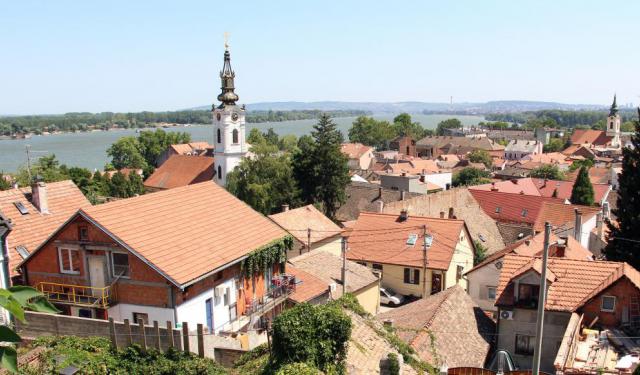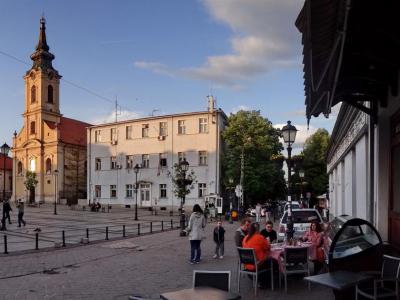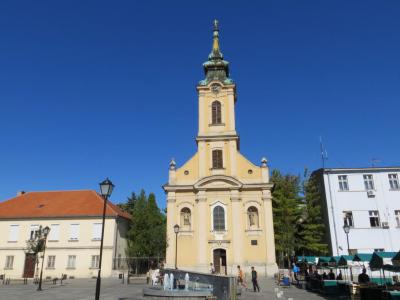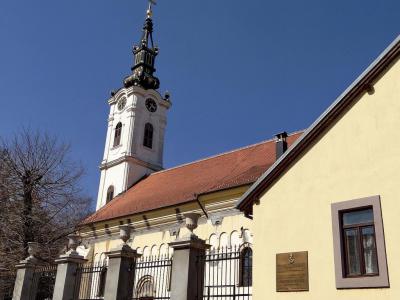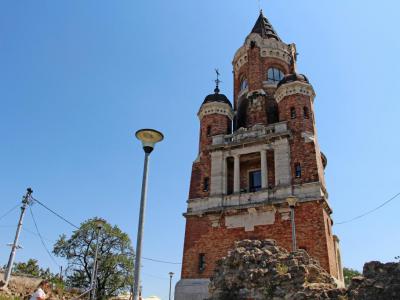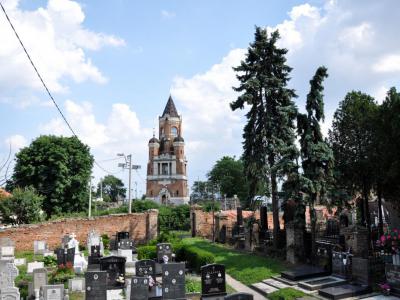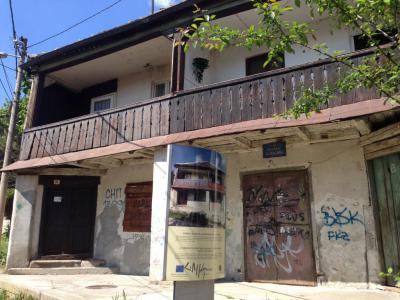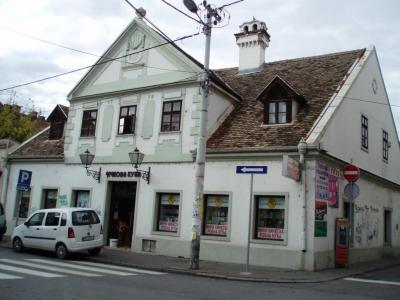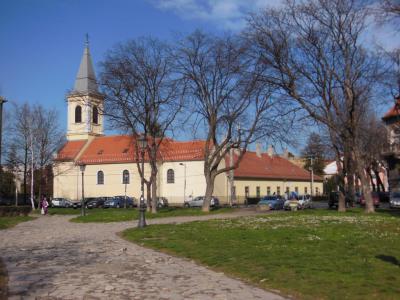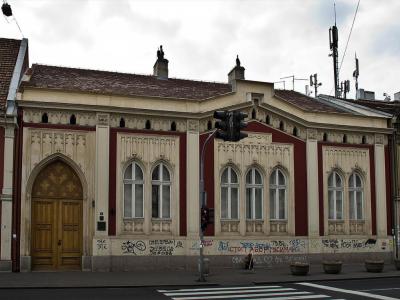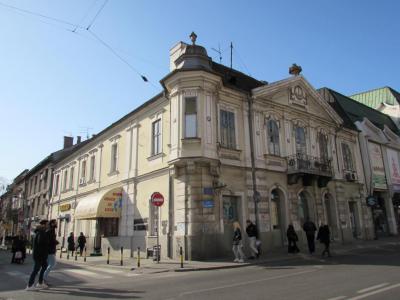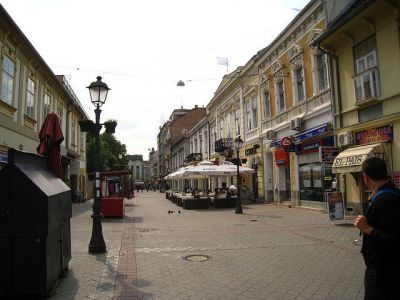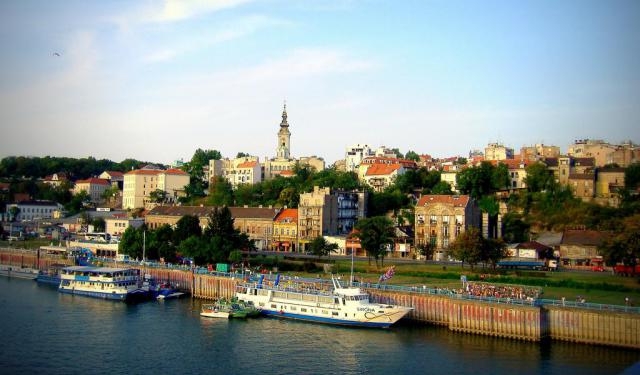Belgrade Old Town (Zemun) Walking Tour (Self Guided), Belgrade
Belgrade's Old Town, also known as Zemun, spread around Gardos Hill, is one of the city's oldest parts. Throughout the centuries, as the Balkans were part first of the Roman, then the Byzantine, and then the Austro-Hungarian empires, this area transformed into a beautiful neighborhood with narrow streets, cute buildings, and breathtaking views opening from the hill onto the Old Town and the Danube River below.
Big Square (Veliki Trg) is the heart of Zemun and a focal point for locals and visitors. This bustling spot is surrounded by picturesque buildings, cafes, and shops, creating a vibrant atmosphere that invites people to explore its nooks and crannies. The on-site market is a must-visit for those looking to immerse themselves in the local culture, offering fresh produce, handmade crafts, and a taste of traditional Serbian cuisine.
One of the prominent landmarks in Zemun is the Catholic Church of the Assumption of the Blessed Virgin Mary. A short walk away from it is another religious gem, the Saint Nicholas Church.
Gardos Tower, an iconic symbol of Zemun, stands tall on the Gardos hill, offering a sweeping panorama of the Danube and the city. The nearby Zemun Cemetery holds historical significance and provides a serene place for reflection.
For those seeking to explore typical Balkan architecture, the White Bear Tavern is the only remaining example of such and the oldest surviving edifice on the urban territory of Belgrade. Another well-preserved historical building in the vicinity is Icko's House.
The Franciscan Monastery of Saint John the Baptist and Saint Anthony is a peaceful sanctuary within the neighborhood, while the Homeland Museum of Zemun provides an excellent opportunity to delve into its history.
Don't miss the House with the Sundial, an architectural gem that adds to Zemun's unique charm, and finally, Gospodska Street, a picturesque thoroughfare lined with quaint shops and eateries, perfect for a leisurely stroll.
Anyone with a taste for historic churches, local delicacies, or simply keen on soaking in the ambiance of charming old streets, will find plenty of this and more in Zemun. So, take our self-guided walk and discover the magic of Belgrade's Old Town, where history, culture, and beauty intertwine in a captivating mix.
Big Square (Veliki Trg) is the heart of Zemun and a focal point for locals and visitors. This bustling spot is surrounded by picturesque buildings, cafes, and shops, creating a vibrant atmosphere that invites people to explore its nooks and crannies. The on-site market is a must-visit for those looking to immerse themselves in the local culture, offering fresh produce, handmade crafts, and a taste of traditional Serbian cuisine.
One of the prominent landmarks in Zemun is the Catholic Church of the Assumption of the Blessed Virgin Mary. A short walk away from it is another religious gem, the Saint Nicholas Church.
Gardos Tower, an iconic symbol of Zemun, stands tall on the Gardos hill, offering a sweeping panorama of the Danube and the city. The nearby Zemun Cemetery holds historical significance and provides a serene place for reflection.
For those seeking to explore typical Balkan architecture, the White Bear Tavern is the only remaining example of such and the oldest surviving edifice on the urban territory of Belgrade. Another well-preserved historical building in the vicinity is Icko's House.
The Franciscan Monastery of Saint John the Baptist and Saint Anthony is a peaceful sanctuary within the neighborhood, while the Homeland Museum of Zemun provides an excellent opportunity to delve into its history.
Don't miss the House with the Sundial, an architectural gem that adds to Zemun's unique charm, and finally, Gospodska Street, a picturesque thoroughfare lined with quaint shops and eateries, perfect for a leisurely stroll.
Anyone with a taste for historic churches, local delicacies, or simply keen on soaking in the ambiance of charming old streets, will find plenty of this and more in Zemun. So, take our self-guided walk and discover the magic of Belgrade's Old Town, where history, culture, and beauty intertwine in a captivating mix.
How it works: Download the app "GPSmyCity: Walks in 1K+ Cities" from Apple App Store or Google Play Store to your mobile phone or tablet. The app turns your mobile device into a personal tour guide and its built-in GPS navigation functions guide you from one tour stop to next. The app works offline, so no data plan is needed when traveling abroad.
Belgrade Old Town (Zemun) Walking Tour Map
Guide Name: Belgrade Old Town (Zemun) Walking Tour
Guide Location: Serbia » Belgrade (See other walking tours in Belgrade)
Guide Type: Self-guided Walking Tour (Sightseeing)
# of Attractions: 11
Tour Duration: 2 Hour(s)
Travel Distance: 2.4 Km or 1.5 Miles
Author: DanaOffice
Sight(s) Featured in This Guide:
Guide Location: Serbia » Belgrade (See other walking tours in Belgrade)
Guide Type: Self-guided Walking Tour (Sightseeing)
# of Attractions: 11
Tour Duration: 2 Hour(s)
Travel Distance: 2.4 Km or 1.5 Miles
Author: DanaOffice
Sight(s) Featured in This Guide:
- Veliki Trg (Big Square) and Market
- Catholic Church of the Assumption of the Blessed Virgin Mary
- Saint Nicholas Church
- Gardoš Tower
- Zemun Cemetery
- White Bear Tavern
- Ičko's House
- Franciscan Monastery of Saint John the Baptist and Saint Anthony
- Homeland Museum of Zemun
- House with the Sundial
- Gospodska Street
1) Veliki Trg (Big Square) and Market
The oldest Zemun square. The arrangement was started in 1784 with the demolition of the Catholic Church and the construction of the City School, the Parish Office, and the Church of the Blessed Children of Mary. It fits perfectly into Masarikov Square, Gardos, and the Millennium Tower. Today, it is one of the favorite zones in the center of Zemun. Big events and a varied cultural and artistic program for all generations take place here.
At the square, visitors can fully immerse themselves in the arts and culture through the many outdoor film festivals, music and art performances, church gatherings, and school plays that take place on the site. Surrounding restaurants and outdoor cafes spill onto the square throughout the day and night, making it a popular gathering place for grocers, residents, and artists of all ages and backgrounds. The restored Zemun market has become a catalyst for the revival of the region, and it is quickly becoming a popular tourist attraction.
The outdoor market in Zemun is the best place to shop for fresh fruits, vegetables, and fish, as well as antiques and some odd objects. Up until 1935, it was a cereal market. Nowadays, there are several rows of the best local produce sold at very affordable prices. The market also works as a flea market, where tourists and collectors may find some truly rare items, mostly from the 20th century.
At the square, visitors can fully immerse themselves in the arts and culture through the many outdoor film festivals, music and art performances, church gatherings, and school plays that take place on the site. Surrounding restaurants and outdoor cafes spill onto the square throughout the day and night, making it a popular gathering place for grocers, residents, and artists of all ages and backgrounds. The restored Zemun market has become a catalyst for the revival of the region, and it is quickly becoming a popular tourist attraction.
The outdoor market in Zemun is the best place to shop for fresh fruits, vegetables, and fish, as well as antiques and some odd objects. Up until 1935, it was a cereal market. Nowadays, there are several rows of the best local produce sold at very affordable prices. The market also works as a flea market, where tourists and collectors may find some truly rare items, mostly from the 20th century.
2) Catholic Church of the Assumption of the Blessed Virgin Mary
The Catholic Church of the Assumption of the Blessed Virgin Mary in Belgrade is a historic Roman Catholic church with a rich and unique heritage. Built in 1795, it stands on the site of a former 16th-century mosque, which was demolished in 1784 during the Austro-Hungarian occupation. This period saw an influx of Catholics into the region, necessitating the construction of a new church. The architectural design of the church was undertaken by Thomas Zagrepčanina Miklaušića.
The church displays a blend of Empire and Baroque architectural elements and features a rather unusual arrangement for a Catholic church, with the altar facing east instead of the traditional west. This distinctive feature sets it apart from many other Catholic churches. Significant restoration work was carried out in 1817 to preserve its structure and beauty.
Located in front of the Zemun Outdoor Market, the church holds a prominent position in the community. Inside, one of the most remarkable features is the Baroque statue of the Black Virgin, made of ebony, alongside statues of Saints Peter and Paul. The church also contains one of the oldest specimens of thorny wood (Gleditsia triacanthos) in the region, standing over 15 meters high. This tree, brought from Jerusalem on the day the foundation stone was laid, has a profound symbolic connection to the crucifixion of Jesus Christ, as its thorns were used to create the crown of thorns placed on Christ's head.
Overall, the Catholic Church of the Assumption of the Blessed Virgin Mary is not only a place of worship but also a historical and architectural landmark, reflecting the cultural and religious evolution of the area.
The church displays a blend of Empire and Baroque architectural elements and features a rather unusual arrangement for a Catholic church, with the altar facing east instead of the traditional west. This distinctive feature sets it apart from many other Catholic churches. Significant restoration work was carried out in 1817 to preserve its structure and beauty.
Located in front of the Zemun Outdoor Market, the church holds a prominent position in the community. Inside, one of the most remarkable features is the Baroque statue of the Black Virgin, made of ebony, alongside statues of Saints Peter and Paul. The church also contains one of the oldest specimens of thorny wood (Gleditsia triacanthos) in the region, standing over 15 meters high. This tree, brought from Jerusalem on the day the foundation stone was laid, has a profound symbolic connection to the crucifixion of Jesus Christ, as its thorns were used to create the crown of thorns placed on Christ's head.
Overall, the Catholic Church of the Assumption of the Blessed Virgin Mary is not only a place of worship but also a historical and architectural landmark, reflecting the cultural and religious evolution of the area.
3) Saint Nicholas Church
Saint Nicholas Church, also known as Nikolajevska Church, is a historic Baroque-style church located in the old downtown area of Zemun, Belgrade. The church stands on the site of an older wooden Serbian temple dating back to the 16th century. Its construction began in 1745 and was completed in 1752.
The church is a single-nave building featuring a semi-vaulted apse and a choir stand, all covered by a barrel vault. A two-story belfry with a metal covering is located on the western side. Designed and built in the Baroque style, the church exhibits typical features of Baroque churches found in Vojvodina and along the Military Border in the 18th century. The northern and southern façades are reinforced with buttresses, adding to the structural integrity and visual appeal of the building.
Saint Nicholas Church holds the distinction of being the oldest Orthodox church in old downtown Zemun and the oldest preserved sacred building in the Belgrade area. It is located below the historic Gardoš fortress, anchoring it firmly within the rich cultural and historical tapestry of the region.
The interior of Saint Nicholas Church is notable for its elaborate decorations, which include a high, richly carved iconostasis considered the most beautiful Baroque iconostasis in Serbian art of the time. The iconostasis was created by Aksentije Marković and features icons painted in 1762 by one of Serbia's most renowned iconographers, Dimitrije Bačević. The church also houses mural compositions by Živko Petrović, icons, banners, and other significant historical artifacts that reflect the cultural and economic history of Zemun.
The church's treasury is a repository of many fine icons from the 18th and 19th centuries, as well as other precious objects, including relics of Saint Andrew. These items underscore the church's role as a vital custodian of religious and cultural heritage.
In 1867, a fire destroyed the original belfry of the church, which was subsequently rebuilt in 1870. Despite this setback, the church has been meticulously preserved, maintaining its historical and architectural integrity through the centuries.
The church is a single-nave building featuring a semi-vaulted apse and a choir stand, all covered by a barrel vault. A two-story belfry with a metal covering is located on the western side. Designed and built in the Baroque style, the church exhibits typical features of Baroque churches found in Vojvodina and along the Military Border in the 18th century. The northern and southern façades are reinforced with buttresses, adding to the structural integrity and visual appeal of the building.
Saint Nicholas Church holds the distinction of being the oldest Orthodox church in old downtown Zemun and the oldest preserved sacred building in the Belgrade area. It is located below the historic Gardoš fortress, anchoring it firmly within the rich cultural and historical tapestry of the region.
The interior of Saint Nicholas Church is notable for its elaborate decorations, which include a high, richly carved iconostasis considered the most beautiful Baroque iconostasis in Serbian art of the time. The iconostasis was created by Aksentije Marković and features icons painted in 1762 by one of Serbia's most renowned iconographers, Dimitrije Bačević. The church also houses mural compositions by Živko Petrović, icons, banners, and other significant historical artifacts that reflect the cultural and economic history of Zemun.
The church's treasury is a repository of many fine icons from the 18th and 19th centuries, as well as other precious objects, including relics of Saint Andrew. These items underscore the church's role as a vital custodian of religious and cultural heritage.
In 1867, a fire destroyed the original belfry of the church, which was subsequently rebuilt in 1870. Despite this setback, the church has been meticulously preserved, maintaining its historical and architectural integrity through the centuries.
4) Gardoš Tower
The Gardoš Tower is a significant historical landmark located in Belgrade. This iconic structure is perched on Gardoš Hill, amidst the remnants of a medieval fortress, and was constructed to commemorate the millennium of Hungarian settlement in the Pannonian plain. The construction of the tower was part of a broader initiative that included several other buildings across Budapest and four-millennium towers situated at cardinal points, reflecting the expansive reach of Hungary within the Austro-Hungarian Empire at the time.
Gardoš Tower was inaugurated on August 20, 1896, marking its place as the southernmost tower of the project, given Zemun's (now a part of Belgrade) status as the southernmost city in Hungary. The design of the tower blends various architectural styles, with a pronounced Roman influence. Its structure is robust and functional, featuring sandstone and custom-made hollow bricks to enhance the durability and weight of the building.
The tower stands 36 meters (118 feet) tall with a base diameter of 18 meters (59 feet). However, its internal diameter narrows significantly to 6 meters (20 feet) at the same level, due to the thick walls which themselves become progressively thinner on higher floors.
Originally, the tower was adorned with an eagle at its pinnacle and various sculptures, including lions and coats of arms, at each rest area (podest). Today, only one of the lion sculptures remains, adding a touch of its erstwhile grandeur to the structure.
The tower has also served practical purposes; for many decades it was used as a lookout by the local fire brigade, thanks to its strategic vantage point. While its historical roots tie it in directly to Janos Hunyadi, who died centuries before its construction, the tower today is a celebrated cultural monument and a popular tourist attraction, offering panoramic views of the surrounding landscapes and a glimpse into the region's complex history.
Gardoš Tower was inaugurated on August 20, 1896, marking its place as the southernmost tower of the project, given Zemun's (now a part of Belgrade) status as the southernmost city in Hungary. The design of the tower blends various architectural styles, with a pronounced Roman influence. Its structure is robust and functional, featuring sandstone and custom-made hollow bricks to enhance the durability and weight of the building.
The tower stands 36 meters (118 feet) tall with a base diameter of 18 meters (59 feet). However, its internal diameter narrows significantly to 6 meters (20 feet) at the same level, due to the thick walls which themselves become progressively thinner on higher floors.
Originally, the tower was adorned with an eagle at its pinnacle and various sculptures, including lions and coats of arms, at each rest area (podest). Today, only one of the lion sculptures remains, adding a touch of its erstwhile grandeur to the structure.
The tower has also served practical purposes; for many decades it was used as a lookout by the local fire brigade, thanks to its strategic vantage point. While its historical roots tie it in directly to Janos Hunyadi, who died centuries before its construction, the tower today is a celebrated cultural monument and a popular tourist attraction, offering panoramic views of the surrounding landscapes and a glimpse into the region's complex history.
5) Zemun Cemetery
Zemun Cemetery, located in Belgrade, on the picturesque Gardoš Hill, serves as a significant cultural and historical landmark within the city. Nestled within the old core of Zemun, this cemetery is bordered by Cara Dušana Street, Nade Dimić Street, Sibinjanin Janka Street, Grobljanska Street, and a staircase leading to Branka Radičevića Square. As a declared cultural monument, it encapsulates the rich history and diversity of the region.
The origins of Zemun Cemetery date back to the period post-1717 when Zemun was liberated from Turkish rule and became part of the Austrian Empire. Initially established for the Catholic population, the cemetery expanded by the late 18th century to include the Orthodox community, relocating the older Orthodox graveyard to the same location. Additionally, a Jewish cemetery was established here after 1739, marking it as a place of interdenominational significance.
Over the centuries, Zemun Cemetery has become the final resting place for a diverse array of individuals, including eminent local figures, artists, scientists, and soldiers. By the mid-20th century, the cemetery had reached its current size, and plans for a new cemetery were considered, although this expansion only materialized after World War II. Today, the cemetery still operates, primarily serving families with pre-existing burial plots.
The Orthodox section houses notable structures such as the protected endowment church of Saint Demetrios, erected by the merchant family Petrović-Hariš in 1876, and a chapel from the Spirta family dated around 1911. It also includes a monument commemorating Serbian soldiers from the 1914–1918 period, along with graves of significant historical and artistic value adorned with sculptures from renowned artists.
The Catholic portion of the cemetery contains a chapel from 1763, adorned with memorial plaques, and another stylized chapel from 1909 belonging to the Treščik family. Notable features include a Neo-Gothic crucifixion sculpture and the graves of nuns who contributed significantly to local hospitals and schools.
The Jewish cemetery at Zemun is one of the oldest in Serbia, continuously used since 1739. It features distinct stone memorials ranging from votive plates to modern tombstones, including that of businessman Gabriel Polgar from 1915.
The origins of Zemun Cemetery date back to the period post-1717 when Zemun was liberated from Turkish rule and became part of the Austrian Empire. Initially established for the Catholic population, the cemetery expanded by the late 18th century to include the Orthodox community, relocating the older Orthodox graveyard to the same location. Additionally, a Jewish cemetery was established here after 1739, marking it as a place of interdenominational significance.
Over the centuries, Zemun Cemetery has become the final resting place for a diverse array of individuals, including eminent local figures, artists, scientists, and soldiers. By the mid-20th century, the cemetery had reached its current size, and plans for a new cemetery were considered, although this expansion only materialized after World War II. Today, the cemetery still operates, primarily serving families with pre-existing burial plots.
The Orthodox section houses notable structures such as the protected endowment church of Saint Demetrios, erected by the merchant family Petrović-Hariš in 1876, and a chapel from the Spirta family dated around 1911. It also includes a monument commemorating Serbian soldiers from the 1914–1918 period, along with graves of significant historical and artistic value adorned with sculptures from renowned artists.
The Catholic portion of the cemetery contains a chapel from 1763, adorned with memorial plaques, and another stylized chapel from 1909 belonging to the Treščik family. Notable features include a Neo-Gothic crucifixion sculpture and the graves of nuns who contributed significantly to local hospitals and schools.
The Jewish cemetery at Zemun is one of the oldest in Serbia, continuously used since 1739. It features distinct stone memorials ranging from votive plates to modern tombstones, including that of businessman Gabriel Polgar from 1915.
6) White Bear Tavern
White Bear Tavern, a historic former tavern (kafana) located in the Zemun municipality of Belgrade, stands as a testament to the region's rich history. First mentioned in historical records in 1658 by French traveler Michel Quiclet, it is recognized as the oldest existing building in modern Belgrade, excluding the Belgrade Fortress. Although the precise construction date is uncertain, it is believed to have been built in the first half of the 17th century, during the period of Ottoman rule.
The building initially served as one of the three major inns in Zemun and was noted for its size. It gained prominence in historical records when Prince Eugene of Savoy stayed there in 1717 while preparing for the siege of Belgrade. Over time, the building underwent various name changes and transformations, notably becoming a traditional Balkan tavern (kafana) in the 18th century.
The architecture of the White Bear Tavern is a prime example of the Balkan Bondruk style, characterized by timber structures filled with unbaked bricks. This one-story edifice is notable for preserving the architectural style of its time and is the only remaining example in the Old Core of Zemun.
Beneath the tavern, a network of underground corridors adds to its historical significance. These were used for storage and refrigeration, utilizing ice cuts from the Danube during winter to preserve food and drinks. One of the lagums, accessible from the first-floor living room of the building's present tenants, is still used as a larder due to its constant year-round temperature.
On 25 August 2023, the state government declared White Bear Tavern a cultural monument.
The building initially served as one of the three major inns in Zemun and was noted for its size. It gained prominence in historical records when Prince Eugene of Savoy stayed there in 1717 while preparing for the siege of Belgrade. Over time, the building underwent various name changes and transformations, notably becoming a traditional Balkan tavern (kafana) in the 18th century.
The architecture of the White Bear Tavern is a prime example of the Balkan Bondruk style, characterized by timber structures filled with unbaked bricks. This one-story edifice is notable for preserving the architectural style of its time and is the only remaining example in the Old Core of Zemun.
Beneath the tavern, a network of underground corridors adds to its historical significance. These were used for storage and refrigeration, utilizing ice cuts from the Danube during winter to preserve food and drinks. One of the lagums, accessible from the first-floor living room of the building's present tenants, is still used as a larder due to its constant year-round temperature.
On 25 August 2023, the state government declared White Bear Tavern a cultural monument.
7) Ičko's House
Ičko’s House is a significant cultural monument located on Bežanijska Street in the Zemun district of Belgrade. Constructed in 1793, this Classical-style building is one of the oldest preserved houses in the area, exemplifying the architectural and urban development of Zemun at the end of the eighteenth century.
The structure comprises a basement, a ground floor, and a partial second floor shaped by a high gable roof with dormers. Originally, the ground floor housed the tavern "Marko Kraljević," while the first floor served residential purposes. The house also featured a yard accessible from Saint Sava Street, which included outbuildings, stables, warehouses, and storage facilities.
The building is named after Petar Ičko, a prominent rebel diplomat and trader, who stayed in the house from 1802 to 1803. Ičko fled Belgrade due to the return to power of the Dahije, Turkish administrators, and settled in Zemun. He played a pivotal role in the preparations for the First Serbian Uprising in 1804, acting as a consul and intermediary for traders in Zemun, Thessaloniki, and other regions.
Over the years, Ičko’s House underwent several reconstructions and a complete revitalization in the 1980s. Today, it retains its historical significance and serves as a representative example of a late eighteenth-century townhouse. The building is currently in use, housing a department store, and continues to be an important part of Belgrade's cultural heritage.
The structure comprises a basement, a ground floor, and a partial second floor shaped by a high gable roof with dormers. Originally, the ground floor housed the tavern "Marko Kraljević," while the first floor served residential purposes. The house also featured a yard accessible from Saint Sava Street, which included outbuildings, stables, warehouses, and storage facilities.
The building is named after Petar Ičko, a prominent rebel diplomat and trader, who stayed in the house from 1802 to 1803. Ičko fled Belgrade due to the return to power of the Dahije, Turkish administrators, and settled in Zemun. He played a pivotal role in the preparations for the First Serbian Uprising in 1804, acting as a consul and intermediary for traders in Zemun, Thessaloniki, and other regions.
Over the years, Ičko’s House underwent several reconstructions and a complete revitalization in the 1980s. Today, it retains its historical significance and serves as a representative example of a late eighteenth-century townhouse. The building is currently in use, housing a department store, and continues to be an important part of Belgrade's cultural heritage.
8) Franciscan Monastery of Saint John the Baptist and Saint Anthony
The Franciscan Monastery of Saint John the Baptist and Saint Anthony holds the distinction of being the only Franciscan monastery in contemporary Belgrade. Established by the Franciscans in 1717, the monastery has a rich history marked by multiple relocations and significant damage over the years, including wartime destruction and burnings. Despite these challenges, the monastery has demonstrated resilience and perseverance.
In 1807, the monastery underwent major reconstruction, revitalizing its structure and purpose. By 1838, a tower was added, enhancing its architectural prominence. One notable feature of the monastery is the Franciscan cross, which has been a significant spiritual symbol at the site since the 18th century and remains in place to this day.
During the 1990s, the Franciscan cloister housed an impressive collection of nearly 6,000 books and various objects of art, underscoring its cultural and historical significance. In recognition of its heritage and importance, both the monastery and its adjoining church have been declared cultural monuments and are currently under state protection.
Today, the Franciscan Monastery of Saint John the Baptist and Saint Anthony stands not only as a place of worship but also as a testament to the enduring legacy and cultural contributions of the Franciscan community in Belgrade.
In 1807, the monastery underwent major reconstruction, revitalizing its structure and purpose. By 1838, a tower was added, enhancing its architectural prominence. One notable feature of the monastery is the Franciscan cross, which has been a significant spiritual symbol at the site since the 18th century and remains in place to this day.
During the 1990s, the Franciscan cloister housed an impressive collection of nearly 6,000 books and various objects of art, underscoring its cultural and historical significance. In recognition of its heritage and importance, both the monastery and its adjoining church have been declared cultural monuments and are currently under state protection.
Today, the Franciscan Monastery of Saint John the Baptist and Saint Anthony stands not only as a place of worship but also as a testament to the enduring legacy and cultural contributions of the Franciscan community in Belgrade.
9) Homeland Museum of Zemun
The Homeland Museum of Zemun, situated in Belgrade, offers comprehensive documentation of Zemun's history from its earliest settlements to the present day. Founded in 1955, the museum initially operated from a different location before relocating to the historically significant Spirta House in 1971.
The Spirta House, erected in 1848 and originally owned by one of Zemun's wealthiest and most influential families, is a notable example of Gothic Revival architecture. This style, popular during the Romanticism period, is distinguished by its Neo-Gothic design and flamboyant windows, making the Spirta House stand out among the surrounding buildings. It is the only preserved representative of Gothic Revival architecture in the wider Belgrade area.
Built as one of the first high-floored family houses in the Old Core of Zemun, the Spirta House's architecture and lush interior reflected the high social status of its owners, a status further elevated by the Spirta family's noble title. Recognizing its cultural and historical value, the Spirta House has been protected as a cultural monument since 1965.
The museum was administratively annexed to the Belgrade City Museum in 1968, and significant adaptations were made to the Spirta House between 1968 and 1970. The museum officially opened in its new location on March 4, 1971. However, in 2002, the museum closed for what was supposed to be a brief 65-day reconstruction. Despite the prolonged closure, the museum temporarily opened for two exhibitions: "A Voice of Zemun" in 2014 and "Secession in the Old Core of Zemun" in November 2017.
The Homeland Museum of Zemun remains a vital institution for preserving and showcasing the rich history of Zemun, with its reopening eagerly anticipated by the local community and visitors alike.
The Spirta House, erected in 1848 and originally owned by one of Zemun's wealthiest and most influential families, is a notable example of Gothic Revival architecture. This style, popular during the Romanticism period, is distinguished by its Neo-Gothic design and flamboyant windows, making the Spirta House stand out among the surrounding buildings. It is the only preserved representative of Gothic Revival architecture in the wider Belgrade area.
Built as one of the first high-floored family houses in the Old Core of Zemun, the Spirta House's architecture and lush interior reflected the high social status of its owners, a status further elevated by the Spirta family's noble title. Recognizing its cultural and historical value, the Spirta House has been protected as a cultural monument since 1965.
The museum was administratively annexed to the Belgrade City Museum in 1968, and significant adaptations were made to the Spirta House between 1968 and 1970. The museum officially opened in its new location on March 4, 1971. However, in 2002, the museum closed for what was supposed to be a brief 65-day reconstruction. Despite the prolonged closure, the museum temporarily opened for two exhibitions: "A Voice of Zemun" in 2014 and "Secession in the Old Core of Zemun" in November 2017.
The Homeland Museum of Zemun remains a vital institution for preserving and showcasing the rich history of Zemun, with its reopening eagerly anticipated by the local community and visitors alike.
10) House with the Sundial
The House with the Sundial is a notable landmark in the central area of Zemun, Belgrade. This 19th-century corner mansion, located at the intersection of Glavna Street and Dubrovacka Street, stands out for its functioning sun clock on the side facing Dubrovacka Street. Constructed in 1823 and adorned with the sundial in 1828, the building is an exquisite blend of Classical style with Baroque elements, incorporating Greco-Roman, Egyptian, and Renaissance art influences. The mansion is built from brick and features a bell cupola and decorative plaster embellishments on its main facade.
The distinctive sundial displays the daytime hours from 8 AM to 3 PM in solar time, showcasing a unique arrangement of figures significant in Serbian astronomical history. The mansion also bears a crest with an anchor, symbolizing its founder’s involvement in maritime trade.
Originally designed as a residential commercial property, the house includes a basement, ground floor, and first floor. The ground floor likely served as a space for bars and shops, while the upper floor remains residential. Despite extensions and damage during World War II, the sundial has remained intact.
Prominent Serbian writer Jovan Subotić spent his final years in this house, contributing to its cultural significance. Subotić, born on January 30, 1817, was known for his diverse literary works, including poetry, drama, and novels. He passed away in the house on January 28, 1886. Another notable resident was writer David Albahari.
Today, the House with the Sundial is a protected cultural monument. Its historical and architectural heritage continues to draw interest and admiration from visitors and locals alike.
The distinctive sundial displays the daytime hours from 8 AM to 3 PM in solar time, showcasing a unique arrangement of figures significant in Serbian astronomical history. The mansion also bears a crest with an anchor, symbolizing its founder’s involvement in maritime trade.
Originally designed as a residential commercial property, the house includes a basement, ground floor, and first floor. The ground floor likely served as a space for bars and shops, while the upper floor remains residential. Despite extensions and damage during World War II, the sundial has remained intact.
Prominent Serbian writer Jovan Subotić spent his final years in this house, contributing to its cultural significance. Subotić, born on January 30, 1817, was known for his diverse literary works, including poetry, drama, and novels. He passed away in the house on January 28, 1886. Another notable resident was writer David Albahari.
Today, the House with the Sundial is a protected cultural monument. Its historical and architectural heritage continues to draw interest and admiration from visitors and locals alike.
11) Gospodska Street
Gospodska Street is a prominent pedestrian shopping lane located in Zemun, Belgrade. Known for its vibrant atmosphere, this tidy street is the central hub of Zemun, attracting visitors with its array of little shops, boutiques, sidewalk cafes, and restaurants. It is not just a commercial center but also a place of historical and cultural significance.
The street is lined with many historic buildings and architectural monuments, making it a picturesque destination for both locals and tourists. One of the key landmarks of Gospodska Street is the Zavetni Cross, a victory memorial erected by Lazar Urosevic in 1863. This memorial stands as a testament to the street’s rich history and its importance in the local community.
Gospodska Street serves as a popular venue for public gatherings and fairs, contributing to its lively and dynamic ambiance. The street's ability to host such events highlights its role as a central meeting place and a focal point for community activities in Zemun.
Gospodska Street is also remembered for the historic Balkan Hotel. This elegant hotel, once a gathering place for intellectuals and merchants, housed the Serbian reading room in its courtyard building. The hotel’s cafe was a popular meeting spot for notable figures, including the famous Serbian storyteller Petar Kocic, who found inspiration for his works here.
Gospodska Street serves as a vital artery of commerce, culture, and community. Its blend of historic significance, architectural beauty, and lively public life makes it a cherished and enduring part of these cities' identities.
The street is lined with many historic buildings and architectural monuments, making it a picturesque destination for both locals and tourists. One of the key landmarks of Gospodska Street is the Zavetni Cross, a victory memorial erected by Lazar Urosevic in 1863. This memorial stands as a testament to the street’s rich history and its importance in the local community.
Gospodska Street serves as a popular venue for public gatherings and fairs, contributing to its lively and dynamic ambiance. The street's ability to host such events highlights its role as a central meeting place and a focal point for community activities in Zemun.
Gospodska Street is also remembered for the historic Balkan Hotel. This elegant hotel, once a gathering place for intellectuals and merchants, housed the Serbian reading room in its courtyard building. The hotel’s cafe was a popular meeting spot for notable figures, including the famous Serbian storyteller Petar Kocic, who found inspiration for his works here.
Gospodska Street serves as a vital artery of commerce, culture, and community. Its blend of historic significance, architectural beauty, and lively public life makes it a cherished and enduring part of these cities' identities.
Walking Tours in Belgrade, Serbia
Create Your Own Walk in Belgrade
Creating your own self-guided walk in Belgrade is easy and fun. Choose the city attractions that you want to see and a walk route map will be created just for you. You can even set your hotel as the start point of the walk.
Belgrade Introduction Walking Tour
Belgrade has been a city of strategic importance for millennia with its location at the confluence of the Sava and Danube rivers. In fact, it is one of the oldest continually inhabited cities on the planet.
Nomadic tribes inhabited the area as far back as 20,000 to 50,000 years ago. Some of these may have been Neanderthals rather than modern humans. By the sixth century BC, the Vinca culture... view more
Tour Duration: 2 Hour(s)
Travel Distance: 4.0 Km or 2.5 Miles
Nomadic tribes inhabited the area as far back as 20,000 to 50,000 years ago. Some of these may have been Neanderthals rather than modern humans. By the sixth century BC, the Vinca culture... view more
Tour Duration: 2 Hour(s)
Travel Distance: 4.0 Km or 2.5 Miles
Kalemegdan Park and Belgrade Fortress Walking Tour
The most beautiful park in Belgrade, Kalemegdan Park, or simply Kalemegdan, is also the largest park and the most important cultural and historical complex in the city. The actual park occupies a smaller portion, in the southern corner, of another, grander monument – the Belgrade Fortress (which is some two millennia older).
The fortress itself, often erroneously referred to, even by the... view more
Tour Duration: 2 Hour(s)
Travel Distance: 2.1 Km or 1.3 Miles
The fortress itself, often erroneously referred to, even by the... view more
Tour Duration: 2 Hour(s)
Travel Distance: 2.1 Km or 1.3 Miles
The Most Popular Cities
/ view all
